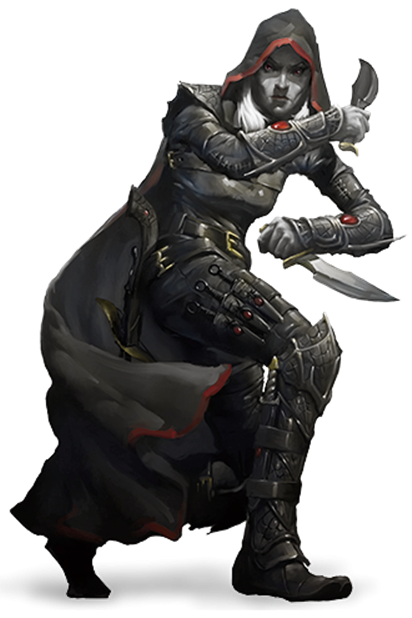How Does the Hide Action Work in D&D 5e?

A common theme I’ve been expanding upon lately is the importance of positioning and battlefield control in D&D 5e combat. Having an advantageous position can be the difference between a victory and a defeat in combat. The Hide action is just one tool that anyone in 5e can take advantage of to help them take such a position in combat.
As the name implies, the Hide action is used in combat for a character to attempt a Dexterity (Stealth) check. Succeeding on this check will grant the character the unseen attacker status which comes with a pair of offensive and defensive benefits.
For most characters, the Hide action won’t be used regularly due to its high action economy cost. However, there are a few classes/subclasses that can and will make regular use of the unseen attacker mechanic, but we’ll touch on that later.
The Hide action, like the Help action and various other optional actions, is situational. Keeping its uses in the back of your mind will be useful should you ever find yourself in a situation where it could be the optimal play as opposed to simply attacking or throwing another spell at the enemy.
The Mechanics of Hiding in D&D 5e
In this section, I’m going to lay out all of the mechanics for hiding while in combat. This, in essence, envelopes two separate mechanics in D&D 5e, the Hide action, and the unseen attacker status.
If you wish to do a bit of digging on your own, you can find all of the relevant information in the Player’s Handbook specifically on pages 192 (hide action) and 194-195 (unseen attacker).
Taking the Hide Action
The Hide action itself is quite straightforward. On your turn, you may use your action to take the Hide action. When you do so, you will make a Dexterity (Stealth) check. If this check is successful, you’ll gain the benefits of being an unseen attacker.
The DM will use the surrounding creature’s passive Perceptions (or have them make Perception checks) to determine whether or not you were able to successfully hide and gain the unseen attacker status.
If you fail your check then nothing happens other than essentially wasting your action in combat. This makes this one of the riskier maneuvers that you can take with your action in combat. Most of the other alternative actions in 5e either give you a defensive bonus or assist an ally. It’s a high-risk, high-reward play for sure!
The Unseen Attacker
Succeeding in this stealth check will grant you the unseen attacker status should you decide to attack from your hidden position. Concerning the narrative, this simply means that you are attacking an enemy who cannot see you.
A quick breakdown of this mechanic reveals that there are two mechanical benefits that an unseen attacker gains:
- Attacks made against a target that you cannot see are made at disadvantage. You also must guess the target’s location. The DM can simply say that the attack missed and does not have to confirm if the target was there in the first place.
- Attacks against a creature that can’t see you are made at advantage.
Attacks made against you are made at disadvantage and your attacks are made at advantage while you are an unseen attacker.
There is a caveat here and that is that once you make an attack, you’ll give away your location once the attack hits or misses. This means that for creatures with Multiattack or PCs with Extra Attack you’ll only have advantage on the FIRST attack you make from your hidden position.
Keep in mind that hiding is not the only way to become an unseen attacker. Casting an invisibility spell or using a class feature that will turn you effectively invisible can also grant you the unseen attacker status!
The unseen attacker status is also why you’ll get advantage on the first attack you make during a surprise round!
Why Hide?
Ensuring Your Next Attack Hits at a Crucial Moment
The encounter is at its climax. One or two more well-placed attacks will finish off each side. You need every advantage you can get! In this scenario, the Hide action may be the best play this turn.
Becoming an unseen attacker will require you to both make a successful stealth check and use this turn’s action, but in doing so you’ll gain some defensive benefits and also gain advantage on the first attack you make from your hidden position.
For example, a character with Sharpshooter may opt to take a Hide action to secure advantage for their devastating -5/+10 attack to finish off their foe.
The issue with taking the Hide action is that it’s a huge investment and has a very real chance of failing if you are not a dexterous character or proficient in the stealth skill. You are giving up an entire action to hopefully gain some defensive benefits and advantage on a single attack.
Don’t get me wrong, in a tight fight, a risky maneuver like this could be the tipping point. However, it could also wind up killing you due to a bad stealth check. Get a feel for your enemy before you use a Hide action. If you feel that they’re particularly perceptive, maybe don’t chance it.

Getting Out of a Tight Bind
There are plenty of reasons why you may want to take the Hide action to actually hide and not just use it as a way to beef up your offensive capabilities. If you are in a situation where you are both in danger of being killed and want to buy a bit of time to either escape or heal up a bit, the Hide action could be the answer.
The only requirement to take a Hide action is that you can hide behind or in something on the battlefield. This isn’t a difficult box to check off, but it’s one you need to be aware of nonetheless.
Using the Hide action defensively in this manner is sort of like using a Dodge action, but also gaining a possible way to escape from the combat encounter. If the enemy loses sight of you, you’ll be protected by forcing them to have disadvantage on their attacks. Plus, if they can’t find you they may just run off looking for you.
Do keep in mind that hiding only makes you unseen and unheard. A creature with an excellent sense of smell can still locate you without much of an issue.
Of course, the difference between using the Hide action and the Dodge action is that the Hide action is not guaranteed to work. It’s a riskier maneuver, but it could certainly work out better for your character in the right scenario.
Who Can Utilize the Hide Action Regularly?
Most PCs won’t be taking the Hide action regularly in combat. There are far too many risks involved for the cost to be worthwhile in my opinion.
However, there are a few classes and archetypes that can and will try to hide at every chance they can get. Typically this is because they can hide as a bonus action as opposed to an action.
Do note that these are not the only classes/subclasses that can utilize the Hide action regularly (or well). I just picked a few of my favorites for this section. I’m sure that there are plenty of other classes/subclasses that could be highlighted in this section. Feel free to add more in the comments though!
The Rogue’s Cunning Action
The rogue has to be one of my top 3 favorite classes in 5e. They have so many fun tools and features to play with in and out of combat and their subclasses are all unique and flavorful. I think part of the reason why the subclasses are all solid is that the base class itself is so solid.
One of the largest factors for the class being such a blast to play for me is the Cunning Action feature that you get as a 2nd-level rogue. This feature allows you to take a Dash, Disengage, or Hide action as a bonus action instead of an action.
This can give you the ability to zoom across the battlefield with two Dash actions in a turn or maneuver through a horde of enemies completely unharmed.
However, with this regular usage of the Hide action, you can secure advantage on your single attack per turn. From a raw damage per round standpoint, a constant stream of attacks made at advantage is already spectacular.
However, having advantage on an attack is also one of the triggers for Sneak Attack making the Hide action a valuable tool to ensure you always get at least one Sneak Attack per turn in combat. Ranged rogues, in particular, should use the Hide bonus action + Attack action combo whenever they can to ensure they always get their Sneak Attack.

The Ranger’s Vanish
The ranger’s Vanish feature is just a knock-off version of the rogue’s Cunning Action. With this feature, a ranger can take the Hide action as a bonus action. It’s nice because it does give the ranger another way to reliably use their bonus action and potentially get advantage on their next attack.
However, it’s also mediocre in the sense that the ranger doesn’t get this feature until level 14.
Rogues at level 2 can Dash, Disengage, or Hide as a bonus action. Rangers can’t even take the Hide action as a bonus action until halfway through the third tier of play.
Regardless, it’s a solid feature that can be coupled with Sharpshooter to dish-out a truckload of damage regularly. My gripe with it is that it just comes online way too late.
The Way of the Shadow Monk’s Shadow Step
I was honestly undecided if I should add this feature to the list here, but I feel as though it’s too badass not to get at least a mention. The Way of the Shadow is a monk subclass that uses their ki to become masters of the darkness. They utilize these special skills to become surprise attackers and experts at stealth.
At 6th-level, this subclass gains the Shadow Step feature. Essentially, when you are in dim light or darkness, you can use a bonus action to teleport 60 ft. to an unoccupied space that’s also in dim light or darkness. When you do so, you have advantage on the first melee attack you make before the end of the turn.
So yes, technically this is not the Hide action and you are not technically an unseen attacker when you do this. However, when it looks like an unseen attacker, sounds like an unseen attacker, it’s an unseen attacker. Well, with some extra stipulations and bonuses.
Also, this feature has no cooldown and doesn’t require the monk to expend any ki points. The only limitations are that the start point and endpoint of Shadow Step must be in darkness or dim light. It’s a fantastic feature.
Conclusions
Some DMs and tables dislike the constant stream of Hide actions since a rogue could just hide behind the same tree every round and have advantage on every attack they make. One way to solve this is to require characters to hide in different locations each time they hide in combat. This makes narrative sense as even the dumbest of creatures would catch on if you’re hiding behind the same rock every single round.
Of course, you could always solve this problem without adding such a stipulation by having the creatures take a ready action for when the rogue pops out from their hiding spot and pelt them with a dozen arrows!
All in all, the Hide action is a valuable tool in combat when used effectively. Most characters will never use it regularly as it’s a risky play, but in the right scenario, it can tip the scales in your favor!

This is a mechanic I rarely see players use, even rogues. Pretty much just seen rogues and rangers use it at a distance to fire shots. But it can be very powerful. Would you ever use it to hide, and then sneak up (I believe at half movement speed) and do a melee attack, like the stereotypical assassin with poison dagger kind of thing?
9 times out of 10 it’ll be used as a ranged attack booster due to how limiting hiding and stealth is in combat.
Approaching a target with an unseen melee weapon attack is difficult because you would need to be completely unseen the entire time you stealth towards the target. It’s heavily dependent on the terrain of the battlefield!
On the other hand, your example works really well as an opening attack in an ambush, which is the assassin’s specialty!